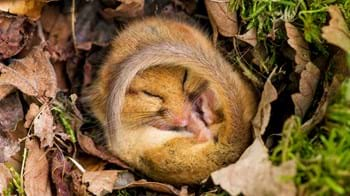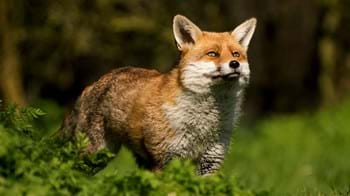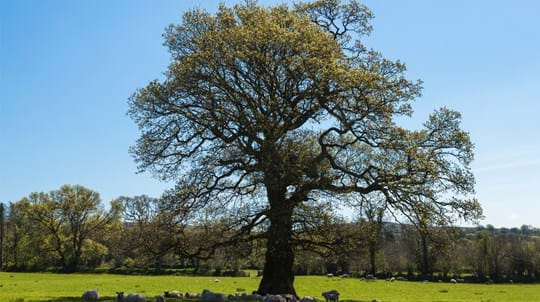
Hall Farm Estate
Harford

Woodland Trust wood group
- Hall Farm
- Gorage Waste
- Hall Plantation
- King's Wood
70.43 ha (174.03 acres)
SX629601
Explorer 28
OS Landranger 202
Hall Farm Estate is a special site. It once belonged to Woodland Trust founder Ken Watkins and is where he brought to life his vision to protect and restore nature. Five decades later, that vision is still at the heart of what we do as the UK's largest woodland conservation charity.
The picturesque farm estate is on the fringe of Dartmoor at Harford and is made up of Gorage Waste, Hall Plantation, King's Wood and Hall Farm. There's a rich mix of habitats including ancient and veteran trees, mature hedgerows, and ancient woodland with temperate rainforest species.
Today, our work at Hall Farm is more exciting and ambitious than ever. We plan to continue the conservation work that Ken started, integrating woods and trees within a regenerative farming system. And we've recently acquired an area of parkland pasture which was part of the farm which means we can expand tree and hedgerow cover on the estate.
As it is now a working farm, Hall Farm Estate is not currently open to the public, although a public footpath does cut through the farm.
Features
- Autumn colour
- Spring flowers
- Grassland
- Moorland
- Broadleaved woodland
How to get to Hall Farm Estate
Hall Farm Estate is situated within Dartmoor National Park close to the small hamlet of Harford.
Unfortunately, there is no access by car to Hall Farm Estate.
Facilities and access
Although Hall Farm Estate is not currently open to the public, a public footpath does run through the farm and is accessible on foot via long-distance footpaths from Ivybridge.
There is no parking at Hall Farm Estate. Vehicular access is only possible via narrow country lanes, but there is no roadside or public parking.
The nearest public toilets to Hall Farm Estate are pay-on-entry, located at Ivybridge on Leonard’s Road. The toilets close from approximately 6pm.
King's Wood is home to the oil beetle - a fascinating species described as having one of the most extraordinary life cycles of any British insect. They are sadly in decline, but we're hoping our work to protect the grassland at Hall Farm Estate will help to boost numbers.
Wildlife and habitats
Hall Farm Estate provides a diverse range of habitats. The farm has three woodland blocks, including recently planted woodland, ancient woodland, and elements of temperate rainforest where the farm watercourse meets the River Erme. The surrounding fields are made up of acid grassland, purple moor grass and neutral grassland.
Animals
The farm's diverse habitats and isolated location close to open moorland make it a haven for wildlife, especially invertebrates like butterflies and beetles including oil beetles - a specialist of wildflower-rich grassland and heathland. Oil beetles are rare nationally but there's a population stronghold in this area of Devon.
Around 40 species of breeding birds have been recorded at the estate including linnet, yellowhammer, grey wagtail, tree pipit and dipper.
There are around 12 species of bat that forage through the woodland, hedgerows, and wet pastures. Bats and owls roost in nooks and crannies of the ancient and veteran trees and historic field barns. Ancient, untamed hedgerows provide vital corridors for small mammals such as voles, shrews and dormice. Higher up the food chain, there are foxes, badgers and buzzards.
Non-native Douglas fir, grand fir, redwood, Western hemlock and Scots pine were once planted over native woodland at King's Wood and Hall Plantation. We are now gradually removing them as our work to restore the original ancient woodland continues.
Trees, plants and fungi
Ancient woodland sits alongside new woodland that was planted in the 1980s although some has also been established through natural regeneration. Pastureland adjacent to the woodland, together with woodland glades, provides habitat for moor grass, rushes, bracken, bilberry and heather.
Trees such as ash, beech, rowan and birch can be found throughout the farm, with gorse in scrubby areas. Stone walls and extensive hedgerows and mature trees link up with woodland copses to create a network of habitats. Scattered veteran and ancient trees grow along old hedge lines and in open fields creating a park-like landscape.
King's Wood has wet woodland characteristics with alder and willow. Twisted and gnarly oaks and ferns grow, and mosses and lichens that are characteristic of temperate rainforest cling onto the branches.
Temperate rainforest is also known as Atlantic or Celtic rainforest. It's an incredibly rare and special habitat - thought to be more threatened than tropical rainforest.
Habitats
Hall Farm is a mix of different habitats. New native woods have been planted alongside the ancient woodland and temperate rainforest. Glades and parkland pastures provide more open areas among the network of untamed hedgerows that link the woods, copses and wider moor. Wet woodland clads land alongside the River Erme at King's Wood.
About Hall Farm Estate
History
Hall Farm Estate is reminiscent of an old deer park with wood pasture and a history of open field systems. It has been a farmstead since the 15th century and was once part of the former Sampford Manor on the edge of Dartmoor. Its history leaves a legacy of veteran trees, medieval wall boundaries and parkland.
In more recent times it was owned by Kenneth Watkins who founded the Woodland Trust. It is now a working farm, so keep an eye out for Hall Farm produce sold locally.

Credit: WTML
A vision for woods, trees and farming
Kenneth Watkins had the vision of farming Hall Farm Estate with conservation at the core and found a young farming family to take on the tenancy with this vision in mind.

Credit: WTML
Continuing Ken's legacy
Though Hall Farm Estate was left to the Woodland Trust, the tenant bought part of it in the 1980s. In 2022 that same farmer retired from farming and the Woodland Trust bought back the farm to ensure Ken's vision and legacy could be continued.
The purchase of the remaining section of Hall Farm Estate was made possible thanks to a generous donation in memory of Heather Corrie who loved trees, butterflies and nature. It was a fitting purchase as we celebrate our 50th birthday.
Walking at Hall Farm Estate
Take a long-distance walk across Dartmoor for the opportunity to explore the quiet footpaths and bridleway that wind their way across this area close to Hall Farm Estate. Outdoor gear suitable for moorland weather is essential along with good map-reading skills.














































